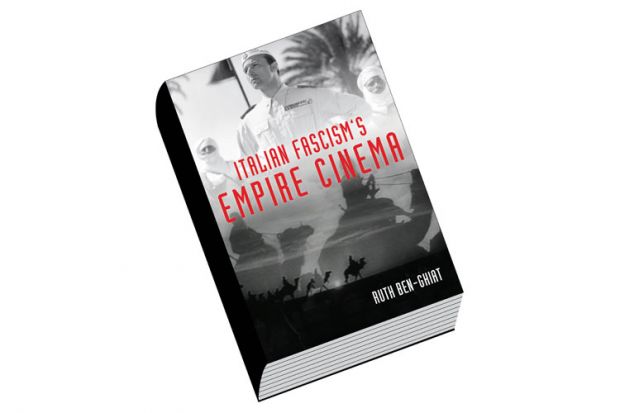In 1941-42, the swaying of the North African front made life difficult for the Fascist Italian film industry. The troupe shooting I cavalieri del deserto, for example, had to flee when Allied forces, shooting in a different manner, approached too near. This movie’s scriptwriters, engaged in adapting a racy Emilio Salgari novel, were Vittorio Mussolini, eldest son of the dictator, and Federico Fellini, famous in the post-war era for his wry portrayals of his people’s peccadilloes. It might seem an unlikely partnership. Yet such conjunctions and disjunctions lie at the heart of Ruth Ben-Ghiat’s fine study of the intricacies of her subject.
Her gaze is directed at films produced in Fascist Italy with themes that tied in with the dictatorship’s violent rule of those colonies it had inherited from the Liberals (Libya, Eritrea, Somalia) and those it conquered (Ethiopia in 1935-36, Albania in 1939). Her purpose, she explains at the end of the book, is to display the “emphatic yet elusive relationship” such Fascist cinema had with “its own times”, a history with its own peaks and troughs, especially as Italy’s Second World War became a story of defeat and imperial loss. Films made in the 1930s centred much of their appeal and message on being shot on site, where the extras, white and black, were “real” and only lead roles were taken by “stars”. By contrast, Bengasi, which won the major prize at the Venice Biennale in the year of its release (1942), was filmed, of necessity, at Rome’s Cinecittà. Nonetheless, the regime did spare 5,000 soldiers from its ever more hard-pressed war fronts to give flesh to the movie’s battle scenes. Here, notes Ben-Ghiat, was a “measure of the importance” of cinema to the regime.
Ben-Ghiat begins with theoretical and historical introductions before transitioning into detailed readings of eight films: Kif Tebbi, 1928; Il grande appello, 1936; Luciano Serra, pilota, 1938; Lo squadrone bianco, 1936, perhaps Augusto Genina’s directorial masterpiece; Sentinelle di bronzo, 1937; L’Esclave blanc/Jungla nera, 1936; Sotto la Croce del Sud, 1938; and Un pilota ritorna, 1942 (one of young director Roberto Rossellini’s “Fascist” trilogy, soon to be replaced on screens by his “Anti-Fascist” trilogy led by Rome: Open City in 1945). She reads with acumen and span, her analysis ably reviewing Italian empire cinema’s parallels with, and differences from, films produced in older and greater empires such as those of Britain and France, in Italy’s Axis partner, Nazi Germany, or in Hollywood, already triumphant in its own imperium of publicity and sales. Despite Fascism’s devotion to “autarchy”, three-quarters of cinema tickets sold in Italy in 1938 were for Hollywood films. With such background sketched, each film is also scrutinised for its messages, witting and unwitting, visual and aural; Ben-Ghiat is acutely aware of sight and sound.
Sometimes readers might fear that the ghost of Derrida lurks in the margins of this monograph, advising that “there is nothing outside the text”. Certainly Ben‑Ghiat does not seriously ask who Vittorio Mussolini and Federico Fellini were in 1942, nor does she question how their relationship functioned. Yet this is a minor quibble. Italian Fascism’s Empire Cinema is the most subtle and detailed examination we have of a crucial element of the cultural practice of “totalitarian” dictatorship, Italian-style.
Richard Bosworth is senior research fellow, Jesus College, Oxford, and author of Italian Venice: A History (2014).
Italian Fascism’s Empire Cinema
By Ruth Ben-Ghiat
Indiana University Press, 420pp, £61.00 and £24.99
ISBN 9780253015525, 5594 and 5662 (e-book)
Published 11 February 2015
POSTSCRIPT:
Review originally published as: Fighting them in the matinees (28 May 2015)
Register to continue
Why register?
- Registration is free and only takes a moment
- Once registered, you can read 3 articles a month
- Sign up for our newsletter
Subscribe
Or subscribe for unlimited access to:
- Unlimited access to news, views, insights & reviews
- Digital editions
- Digital access to THE’s university and college rankings analysis
Already registered or a current subscriber? Login




